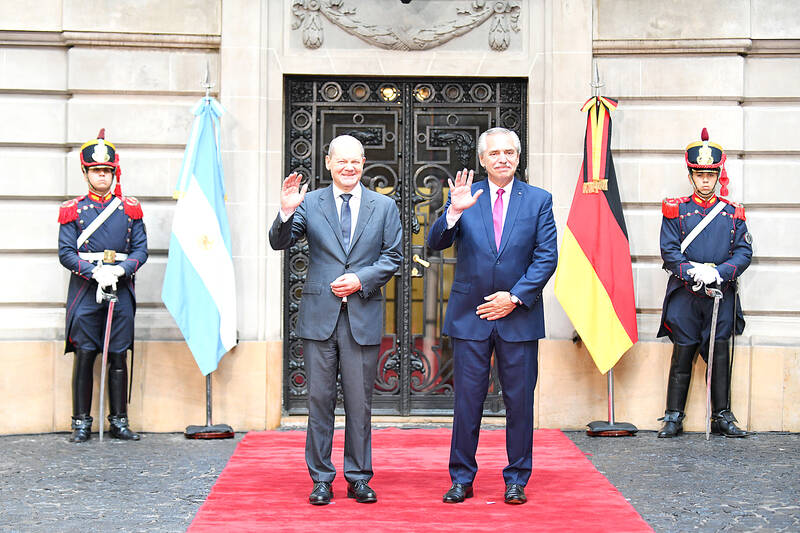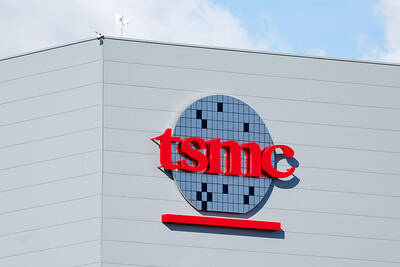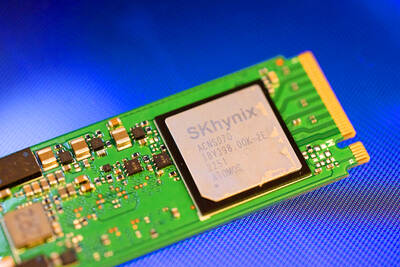German Chancellor Olaf Scholz on Saturday urged a swift conclusion to talks on a free trade deal between the EU and the Mercosur South American trade bloc during a stop in Buenos Aires on his inaugural tour of the region.
Seeking to reduce Germany’s economic reliance on China and diversify trade with democracies worldwide, Scholz is visiting Argentina, Chile and Brazil, all led by fellow leftists who came to power in the region’s new “pink tide.”
Berlin wants to lower its dependence on China for minerals key to its energy transition, making resource-rich Latin America an important partner. The region’s potential for renewable energy output is another attraction.

Photo: EPA-EFE
“There is great potential to further deepen our trade relations, and the possibilities that could come from the EU-Mercosur deal are obviously particularly significant,” Scholz told a news conference alongside Argentine President Alberto Fernandez.
Fernandez has blamed European protectionism for delaying the deal, agreed to in principle in 2019, but not ratified by national parliaments.
EU ambassadors have said Brazil must take concrete steps to stop soaring destruction of the Amazon rainforest.
Berlin hopes that the concern can be put aside with the election of Brazilian President Luiz Inacio Lula da Silva, who has promised to overhaul the country’s climate policy. Scholz is to meet him today at the end of his three-day tour.
Russia’s invasion of Ukraine, which sparked an energy crisis in Germany due to its heavy reliance on Russian gas, increased awareness of the need to reduce economic reliance on authoritarian states.
For Germany to reduce its reliance on China for minerals, it must embrace sectors it has shied away from, a German government official said on Friday.
“For example, lithium mining — that’s a challenging task, especially regarding the environment and social standards,” the official, traveling with Scholz, told reporters.
Argentina and Chile sit atop South America’s “lithium triangle,” which holds the world’s largest trove of the ultra-light battery metal.
Several business executives — including the heads of Aurubis AG, Europe’s largest copper producer, and energy company Wintershall Dea AG — are accompanying the chancellor.
Fernandez said he and Scholz discussed the possibility of attracting German investment to the country’s vast shale gas reserve, lithium deposits and green hydrogen production.
Wintershall Dea, for example, is part of a consortium that in September last year announced it was investing about US$700 million to develop a gas project off the coast of Argentina’s southernmost tip, Tierra del Fuego.
“Argentina has the potential to supply Europe with energy in the long term,” Wintershall CEO Mario Mehren said in a statement.

Taiwan Semiconductor Manufacturing Co (TSMC, 台積電) secured a record 70.2 percent share of the global foundry business in the second quarter, up from 67.6 percent the previous quarter, and continued widening its lead over second-placed Samsung Electronics Co, TrendForce Corp (集邦科技) said on Monday. TSMC posted US$30.24 billion in sales in the April-to-June period, up 18.5 percent from the previous quarter, driven by major smartphone customers entering their ramp-up cycle and robust demand for artificial intelligence chips, laptops and PCs, which boosted wafer shipments and average selling prices, TrendForce said in a report. Samsung’s sales also grew in the second quarter, up

LIMITED IMPACT: Investor confidence was likely sustained by its relatively small exposure to the Chinese market, as only less advanced chips are made in Nanjing Taiwan Semiconductor Manufacturing Co (TSMC, 台積電) saw its stock price close steady yesterday in a sign that the loss of the validated end user (VEU) status for its Nanjing, China, fab should have a mild impact on the world’s biggest contract chipmaker financially and technologically. Media reports about the waiver loss sent TSMC down 1.29 percent during the early trading session yesterday, but the stock soon regained strength and ended at NT$1,160, unchanged from Tuesday. Investors’ confidence in TSMC was likely built on its relatively small exposure to the Chinese market, as Chinese customers contributed about 9 percent to TSMC’s revenue last

LOOPHOLES: The move is to end a break that was aiding foreign producers without any similar benefit for US manufacturers, the US Department of Commerce said US President Donald Trump’s administration would make it harder for Samsung Electronics Co and SK Hynix Inc to ship critical equipment to their chipmaking operations in China, dealing a potential blow to the companies’ production in the world’s largest semiconductor market. The US Department of Commerce in a notice published on Friday said that it was revoking waivers for Samsung and SK Hynix to use US technologies in their Chinese operations. The companies had been operating in China under regulations that allow them to import chipmaking equipment without applying for a new license each time. The move would revise what is known

UNCERTAINTY: A final ruling against the president’s tariffs would upend his trade deals and force the government to content with billions of dollars in refunds The legal fight over US President Donald Trump’s global tariffs is deepening after a federal appeals court ruled the levies were issued illegally under an emergency law, extending the chaos in global trade. A 7-4 decision by a panel of judges on Friday was a major setback for Trump, even as it gives both sides something to boast about. The majority upheld a May ruling by the Court of International Trade that the tariffs were illegal. However, the judges left the levies intact while the case proceeds, as Trump had requested, and suggested that any injunction could potentially be narrowed to apply